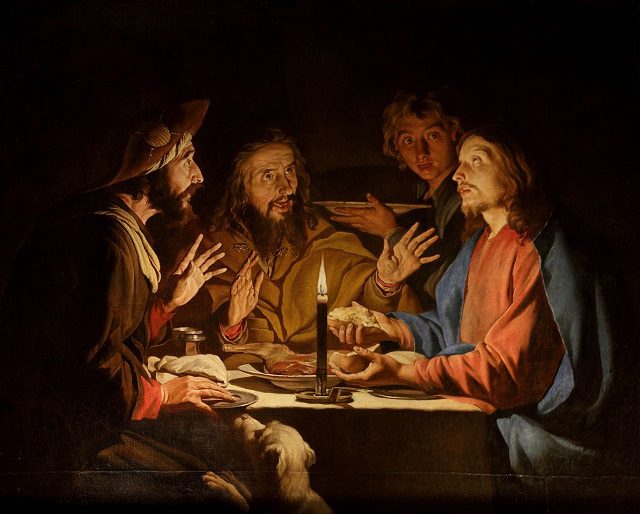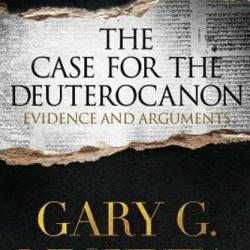
This is what our friend “DagoodS” (former fundamentalist Christian and now atheist) does: he loves to gleefully suggest supposed contradictions in the Bible, so he can feel all the more comfortable and comfy-cozy in his relatively new atheist “skin.” He can confidently, triumphantly face each new day with his head held high, “knowing” that he has refuted those ignorant, lying, intellectually dishonest Christian apologists once again. He correctly understands the Bible; we Christians don’t, because (so he tells us) we are blinded by our belief in inspired written revelation.
Everyone has their natural biases of party affiliation; sure. I’ve always acknowledged that. But there is bias, and there is BIAS (if you know what I mean). I’ve often said that atheists of his sort approach the Bible like a butcher approaches a hog. DagoodS is on record as not appreciating that description. But it’s true in his case and that of most atheists who deign to do what they consider to be “biblical exegesis.” He sees what he wants to see. When it comes to butchering individual Bible passages we Christians refer to that with the 50-cent word eisegesis, which means literally “reading into the text [what is not there].”
We can be assured that when DagoodS sets out to “interpret” the Bible the result always comes out the same: the Bible is untrustworthy and self-contradictory. It’s made up. It’s not what it purports to be: not even on the level of historical analysis and verification (wholly apart from the question of error-free inspiration).
Now, it is true, on the other hand, that when Christians (like myself), who believe in biblical inspiration and infallibility, interpret the Bible, it “comes out” harmonious and self-consistent. Very true. We have a bias “fer,” and the atheist has a bias “agin” the Bible. That’s a given. So all we can do is apply the logic and common sense that both sides presumably have (or should have) in common, and let the reader determine which individual interpretation is more plausible and reasonable to hold. This will be an opportunity for readers to do just that.
I shall be examining DagoodS’ post entitled “Picking and Choosing” (3-4-08). His cited words will be in blue. He sets the stage in his paper:
Prior to a trial, each side has to present to the other an Exhibit List—a pleading detailing what documents and items they intend to introduce at trial. It is no surprise the lists between opposing parties disagree. Why? Because each side is picking (out of ALL possible Exhibits) those which support their case.
When looking for support for our position, we look for those with similarities. We even overlook great dissimilarities to focus on minute agreement. . . .
One of the areas in which I watch this happening is the attempt to reconcile the resurrection appearances of Jesus among the canonical books. Similarities are trumpeted; inconsistencies are down-played. . . .
. . . assuming this was a credo of some sort [1 Cor 15:3-8], passed from Christian to Christian eventually falling on Paul’s ears—what does it say about the Gospel stories which have very different accounts? How is it the Gospel of Matthew, if written by one of the Disciples, does not align with the credo? Nor the Gospel of John—also an alleged eyewitness according to Christian tradition?
Many Christian apologists attempt to place this credo early; unwittingly forfeiting the reliability of the Gospel accounts. They want us to look at the similarities, and ignore the differences.
Having plainly stated his thoroughly hostile presuppositions, DagoodS then summarizes the post-Resurrection accounts:
1 Corinthians
1. Cephas (presumably Peter)
2. “The Twelve” (title of the Disciples)
3. Over 500 brethren at once
4. James, the brother of Jesus
5. All the apostles
6. Paul.Mark
Has no appearances.
Matthew
1. Mary Magdalene and the Other Mary
2. Eleven DisciplesLuke
1. Simon? (24:34)
2. Cleopas and ____ on the Road to Emmaus
3. Eleven and those who were with them.
4. Apostles. (Acts 1:2)John
1. Mary Magdalene
2. Ten Disciples (No Thomas)
3. Eleven Disciples.
4. Peter, Thomas, Nathanial, sons of Zebedee and two other disciples
These are assumed throughout to be contradictory (“dissimilarities . . . attempt to reconcile . . . inconsistencies . . . does not align . . . forfeiting the reliability of the Gospel accounts . . . differences . . . very different”). Let’s take a closer look to see if his opinion can withstand scrutiny. It has always been the case with DagoodS’ anti-biblical arguments, every time I have scrutinized them: they always appear to be strong at first glance but they are actually as weak as a house of wet cards when closely examined.
What is striking is not only the differences in order, but the actual persons involved.
My my; how astonishing that different writers dare to highlight different people who saw the risen Jesus!!! How dare they do that! Don’t they know that self-deluded atheists 2000 years later will pick through their accounts and falsely allege trumped-up contradictions, so they can run around proclaiming how ignorant and stupid Christians are, to believe such tripe?
The credo does not include the women—who are in both Matthew and John.
Even if true; so what? Other biblical books did, so that information is in there. Who says every single fact needs to be in each book? There is no such “rule.” That level of repetition is neither necessary nor required: certainly not to avoid the silly charges of “contradiction” spewed out at every opportunity by atheists and other Bible skeptics who seem constitutionally unable to see the forest for the trees.
I deny, however, that Paul doesn’t mention women at all (if this is implied), because 500 “brethren” (1 Cor 15:6) certainly includes women, as the term (adelphos) has a very wide range of meaning, including kinfolk, ethnic group, all Christians (e.g., Mt 23:8; Jn 21:23; Acts 6:3; 9:30; 11:1; Rom 8:29; 1 Cor 5:11; Gal 1:2; Phil 1:14), and all people (Acts 17:26; Heb 2:11). Paul’s own sister is called adelphe at Acts 23:16. We can safely assume that in a crowd of 500 Christian believers, women were present. Even DagoodS could begrudgingly agree to that, I think.
But if DagoodS means only Mary Magdalene and the other Mary (which is probably the case, I think), again, I say, “so what?” If they are included in the lists of Matthew and John, of what necessity is it, that Paul also “must” mention them? In DagoodS’ illogical, jaded mentality, not being mentioned automatically means “denial” and hence, contradiction.
The credo specifically lists James—again unmentioned in the Gospels.
This is insignificant as well, because it was an event that happened later on. The Gospels describe the appearances shortly after the death of Jesus and hence don’t mention later ones, such as to the 500, and to Paul and James. James came to the faith later on. He is described as skeptical in the Gospels themselves (cf. Mt 13:55 and Mk 3:21). This is no contradiction: much as DagoodS would hope that it is.
And finally lists “all the apostles” which is an unknown group comprised of unknown individuals, and unaccounted for in the gospels as well, although possibly included in Luke’s second book of Acts.
See the previous comment.
The credo includes this count of “over 500 brethren” which are not mentioned in any of the gospels.
Why does DagoodS seem to think this is of some grave importance, in order to maintain the integrity of the different accounts? It just isn’t . . . This is his game but it is illogical, altogether sloppy, shoddy thinking.
Oddly, Acts 1:15 records the total number of “brethren” as being only 120. This is the same word used by Paul—how could it drop from 500 to 120?
This is a classic instance of DagoodS’ wooden literalism: no doubt a remnant of his old rigid fundamentalism. He shows no consideration whatever of context: either in the immediate passage or in the historical sense of when each event occurred. Acts 1:15 is reporting about the time shortly after Jesus’ ascension into heaven: even before the day of Pentecost. So this is very early. Presumably all the Christians were staying together at this early stage (implied by Acts 1:12-14).
After Peter preaches, as a result of the extraordinary events on the day of Pentecost, we learn that “there were added that day about three thousand souls” (Acts 2:41; RSV, as throughout). Acts 2:47 adds: “the Lord added to their number day by day those who were being saved.” This all took place before Paul was in the picture. The numbers were multiplying due to preaching and miracles. Again, Acts 5:14 reports: “And more than ever believers were added to the Lord, multitudes both of men and women.”
Acts 6:1 refers to “in these days when the disciples were increasing in number . . .” Acts 6:7 states: “And the word of God increased; and the number of the disciples multiplied greatly in Jerusalem . . .” Paul is first mentioned at Acts 7:58, and he is still hostile to Christianity. Therefore, he had not yet had his vision, which came after the 500 saw Jesus. By that time, there were more than enough Christians around, for 500 to see the risen Jesus.
We have all this information, yet DagoodS makes an astonishingly ignorant remark about “how could it drop from 500 to 120” — ignoring all of this relevant data, and expecting that this will seem to be impressive reasoning to fellow atheists, who never meet an objection to the Bible they don’t like: no matter how ludicrous. It truly is extraordinary.
Luke seems to have no knowledge of any appearance to Peter prior to the disciples (note the words are placed in other people’s quotes, with no indication of any event occurring) . . .
The silliness never ends with DagoodS. Now he is quibbling about someone else mentioning Peter seeing the risen Jesus (Luke 24:34). In his list of appearances, he questions [question mark] whether “Simon” is Peter; everyone (who knows anything about the New Testament) knows that it is him: his given name was Simon, and Jesus usually called him that, until he re-named him “Rock” (Peter / kepha). Yet he claims that Luke “seems to have no knowledge” of an appearance to Peter (Luke 24:34 disproves this!).
In Luke, Mary Magdalene and the other women are clearly presented as seeing the risen Jesus before the disciples do (Lk 24:1-12). The narrative then switches to the two disciples walking to Emmaus. But that is not immediately after the account of the women, because the text says “That very day . . .” (Lk 24:13). When these two return to Jerusalem, they find the eleven disciples, who report that Simon (Peter) had seen the risen Lord. This doesn’t necessarily imply that they had not also seen Him. Peter is mentioned because he was the leader of the disciples, and consistently portrayed that way in the Gospels and also the book of Acts (see my 50 NT Proofs for Petrine Primacy).
The (non-contradictory) chronology is clarified in the book of John, where Mary Magdalene (note that the text doesn’t deny that there were women with her) sees the empty tomb first (Jn 20:1). She then informs Peter and John (20:2), who run and also see the empty tomb (20:3-10). Then Mary Magdalene actually sees Jesus (20:11-17). She tells the disciples that (20:18; cf. Lk 24:8-10), but the disciples were skeptical (Lk 24:11). By that night, Jesus had appeared to the disciples (minus Thomas), and they believed (Jn 20:19-23).
and [Luke] does not include any appearance to James.
Explained above: it is a later event not intended to be dealt with by the Gospel writers.
The subject of the Resurrection accounts and how they can be harmonized is a fascinating one for Bible students. I ran across an article from the always superb Christian Think Tank site, by Glenn Miller, entitled, “Do the Resurrection accounts HOPELESSLY contradict one another?” A number of excellent, super-relevant points are made. He approaches the question in the following manner (which I think is exactly right), providing five guidelines and brilliantly examining each factor in turn:
1. The absolute necessity of conjecture in historical reconstructions
Anybody that has “done” any history knows that the “just the facts” position above is simply absurd. History is reconstructive in its concrete practicality. To show this, it is sufficient to simply cite passages from standard works/textbooks on historical method. [four textbook examples provided] . . .
What this means for us is simple: we are SUPPOSED to come up with ‘glue’ explanations, plausible conjectures, and hypothetical ‘narratives’–to weave the historical facts into a comprehensible whole. It is simply historical method that dictates that we will try to integrate (via interconnections and “induced” facts) the various historical data we have. It is not ‘special pleading’ or ‘speculation’–anymore that constructing a history of Tiberius from the disparate and wildly divergent sources of Tacitus, Suetonius, Velleius Paterculus, and Dio Cassius would be. History is composed of inferential thinking and hypotheses.
2. The significance of different details in the accounts (from the standpoint of evidence)
No one disputes that the surface structure of the Easter narratives contains a large number of differences in details. The narratives themselves are not complete, of course, since each author selected only the details relevant to his literary purpose; so we would expect SOME LEVEL of complementary information (which is sometimes interpreted as ‘contradiction’!), but the amount of these surface differences has historically been quite a discomfort to the casual reader or beginning student.
In actual fact, however, these differences serve both to (1) ‘tip us off’ to the author’s intended purpose (e.g. what facts from a shared body of information did the author SELECT to include)–VERY important to exegesis; and to (2) lend additional weight to the credibility of the accounts! While it might seem odd to a reader to say that the apparent discrepancies between the narratives ENHANCES THE CREDIBILITY of those narratives(!), this is exactly what experts in evidence say. [gives four legal-type examples] . . .
The point should be clear–the surface structure IS puzzling; but instead of casting doubt on the passages, this structure actually turns out to be a reason to accord the narratives higher credibility.. . . the the differences in the accounts are very IMPORTANT to us–they give us additional reason to trust the testimony of these men . . .
3. The legitimacy of harmonization attempts relative to historical material;
We have already seen above that building an “imaginary narrative” that is essentially integrative, from “all the confusing phenomena,” is the essence of historical method. So, ‘harmonization’–the attempt to render a unified narrative from disparate narratives–should be understood as a legitimate step in this process. . . . it is standard practice in classical historiography, . . . Not only is harmonization a basic and standard tool of the historian; it is likewise a rigorous and DAILY tool of those who “get paid” to evaluate evidence–the legal profession! . . . Evangelicals agree that forced harmonizing (of which there are many, many comical and/or deplorable examples!) is illegitimate, but that the opposite extreme of dismissing exegetical efforts to follow standard historical praxis is likewise foolish.. . .
Notice that this account [Wenham’s] has all the elements of historical inquiry–both conjectural and “imaginary” as well as supportive–e.g.,the “three reasons”. It does NOT assume that the authors were under some kind of constraint to provide a list of all the incidental characters in the story–they only needed to marshal the relevant details for their specific literary intent and purpose.
The point should be clear by now: harmonization is a standard, essential part of BOTH historical inquiry AND legal assessment of testimony of witnesses. As such, it is not ‘alien’ to the biblical students task, nor is it something to be practiced woodenly. The student of ANY history (not just ‘biblical’ history) is not only sanctioned in the praxis of harmonization, but he or she is literally compelled to do–under the methodological norms of historiography. [four supporting quotations omitted]
4. The issue of “plausibility” of explanations.
“Plausibility” is a notoriously subjective concept, and one that engages epistemologists to no end. Oxford dictionaries define “plausible” as “seeming reasonable or probable”, but this will not get us very far. What seems “reasonable” to one may seem unreasonable to another. “Reasonable” could entail simply the notion can I can make a “rational” argument–one in which a conclusion is supported by some appeal to accepted premises or evidence. In the case of “reasonable”, all one has to do is demonstrate that the explanation under question is POSSIBLE, given what we know about the situation and players in the scenario under study.
“Probability” is, however, of somewhat more strength, but is still very loaded. Probability would need to be greater than 25-30%, say, for something to be considered ‘plausible’, but even the determination of some “threshold” percentage will be difficult in historical events.
Given this somewhat ambiguous criterion, let’s examine two skeptical passages to see how this ‘plausibility’ criterion plays out.
[he then does fabulous lengthy refuting examinations of skepticism from Dr. Robert Price and Farrell Till]
5. Several specific reconstructions/sequencing of the post-resurrection events (or appearances of Christ)
I have assembled here several harmonizations or sequences of appearances of Christ. Some are extended entries (e.g. Archer), some are short lists (e.g. Ryrie, Willingham), some are merely statements of how specific difficulties are to be resolved (e.g. Blom), and still others are detailed summaries (e.g. Harris). Most of these harmonizations will differ in some details, indicating the reality that there are MULTIPLE WAYS to harmonize the accounts! The Christian need not be concerned over whether or not THERE IS a defensible and “plausible” answer; the tough question is “of the 10 plausible reconstructions, WHICH ONE is the best, in my opinion?”–a radically different situation.
Such is the case with these Gospel accounts. With further study, the apparent contradictions disappear. For example, all four accounts are in harmony with the following sequence of events: Very early a group of women, including Mary Magdalene, Mary the mother of James, Salome, and Joanna set out for the tomb. Meanwhile two angels are sent; there is an earthquake and one angel rolls back the stone and sits upon it. The soldiers faint and then revive and flee into the city. The women arrive and find the tomb opened; without waiting, Mary Magdalene, assuming someone has taken the Lord’s body, runs back to the city to tell Peter and John. The other women enter the tomb and see the body is gone. The two angels appear to them and tell them of the resurrection. The women then leave to take the news to the disciples. Peter and John run to the tomb with Mary Magdalene following. Peter and John enter the tomb, see the grave clothes, and then return to the city, but Mary Magdalene remains at the tomb weeping, and Jesus makes His first appearance to her. Jesus next appears to the other women who are on their way to find the disciples. Jesus appears to Peter; He appears to the two disciples on the road to Emmaus; and then appears to a group of disciples including all of the Eleven except Thomas.
[retired judge and lawyer/solicitor/barrister Herbert C. Casteel, Beyond a Reasonable Doubt, College Press: 1992, 2nd rev., pp.212-213] [seven other harmonization scenarios also offered]
Miller then summarizes all of the foregoing:
- I have obviously not resolved all the surface phenomena of the narratives, nor have I even attempted to do so.
- I have shown that the methods used by thinking and conscientious evangelicals–harmonization and integrative narrative reconstruction–are legitimate and important.
- I have argued that the Christian does not necessarily have to submit to external and foreign criteria for ‘plausibility,’ and that the historical student should be a critical thinker relative to those who would attempt to impose arbitrary criteria on the process.
- I have given examples of appropriate harmonization.
- I have argued that the apparent divergence at the surface level of the narrative accounts is actually something to appreciate! That these differences are important for both understanding and the extra ‘weight’ of credibility of the gospel accounts.
All of this taken together disposes of DagoodS’ objections. He obviously sought no Christian answers to his incessant agonized “difficulties” with Holy Scripture. He just gives his “atheist sermon” — knowing that his fellow atheists will soak it up and not give a thought to possible Christian replies.Glenn Miller offers a fantastic amount of material on his site, that deals in excruciating length with just about every stock, garden-variety skeptical argument about the Bible that one can imagine. But does DagoodS — the eternal Bible skeptic — show any awareness of his site? Nope. A search of his blog revealed no instances at all of “Glenn Miller” ever being mentioned. Ignorance is bliss . . .
In any event, once again (as always), DagoodS has not actually demonstrated a true contradiction: in any conventional definition of that term. He merely asserts or insinuates it. He’s the master of the superficial, surfacey treatment of Holy Scripture. We mustn’t ever examine it in the depth it deserves: that he would accord any other document.
Let’s conclude by showing some facts about alleged contradictions that actually aren’t:
1) 1 Corinthians 15:5 does not assert that he first appeared to Peter (Cephas), it simply says that “he appeared to Cephas, then to the twelve.” So we know from this that he saw Jesus before the disciples as a group did (and before the 500 and James, and “apostles” and Paul himself), but it doesn’t logically require that he was the very first.
2) Likewise, Luke 24:34 doesn’t say Jesus appeared first to Peter. Thus, neither passage entails a contradiction with Matthew and John’s report of women first seeing Him.
3) I submit that Paul started his list with Peter not because of some intended slight to women, but because he was the acknowledged leader of the apostles, and of earliest Christianity, and this was significant in terms of eyewitness testimony. It would be like citing the President of a company as an eyewitness, rather than some second-tier workers who saw the same thing.
It carries more force. Paul singled him out as the leader (consistent with the Gospels) by mentioning him only; for example, in 1 Corinthians 9:5: “as the other apostles and the brothers of the Lord and Cephas?” When he began his ministry, Paul went to see Peter for fifteen days, and “none of the other apostles except James” (Gal 1:18-19).
4) Descriptions of appearances to the disciples as a group do not rule out an appearance to Peter beforehand. To rule this out logically, it would have to say something like, “He appeared to the disciples and this was the first time any of them had seen the risen Jesus.”
5) Accounts given in one book only (e.g., the 500 in 1 Corinthians, and disciples on the road to Emmaus in Luke) do not contradict accounts that do not contain them. Rather, they complement, adding new data.
6) DagoodS states in the combox: “And there is simply no way to confirm this ‘500’ number. As I noted, it is not adhered to by any canonical work, and actually contradicts Luke/Acts. “ As usual, he doesn’t demonstrate this alleged “contradiction.” I say he doesn’t try because he has no case, It can’t be done.
7) DagoodS’ own list of the four books’ accounts of the risen Jesus, that he tosses out, thinking that it is obvious to anyone (besides one billion Christians) that the data is contradictory, can easily be harmonized in a number of internally consistent ways. I shall denote each of his listings according to the first letter of the book and the number as he arranges it within the book:
DagoodS’ Categories and Instances by Book
C1. Cephas (presumably Peter)
C2. “The Twelve” (title of the Disciples)
C3. Over 500 brethren at once
C4. James, the brother of Jesus
C5. All the apostles
C6. Paul.M1. Mary Magdalene and the Other Mary
M2. Eleven DisciplesL1. Simon? (24:34) [Yes, Peter]
L2. Cleopas and ____ on the Road to Emmaus
L3. Eleven and those who were with them.A1. Apostles. (Acts 1:2)
J1. Mary Magdalene
J2. Ten Disciples (No Thomas)
J3. Eleven Disciples.
J4. Peter, Thomas, Nathanial, sons of Zebedee and two other disciples
Murray Harris’ Chronological Schema of Post-Resurrection Appearances of Jesus (as summarized by Glenn Miller)
1. Mary Magdalene followed Peter and John to the tomb, saw two angels inside, and then met Jesus (John 20: 11-17; cf Mark 16:9).
2. Mary (the mother of James and Joses) and Salome met Jesus and were directed to tell his brethren to go to Galilee (Matt. 28:9-10).
3. During the afternoon Jesus appeared to two disciples on the way to Emmaus. They then returned to Jerusalem to report the appearance to the Eleven and others (Luke 24:13-35; c£ Mark 16:12-13).
4. Jesus appeared to Peter (Luke 24:34; 1 Cor. 15 :5).
5. That evening Jesus appeared to the Eleven and others (Luke 24:33), Thomas being absent (Luke 24:36-43; John 20:19-23; 1 Cor. 15:5; cf Mark 16:14).
6. One week later Jesus appeared to the Eleven, Thomas being present (John 20:26-29) .
7. Seven disciples had an encounter with Jesus by the Sea of Tiberias in Galilee (John 21: 1-22).
8. The Eleven met Jesus on a mountain in Galilee (Matt. 28:16-20; cf Mark 16:15-18).
9. Jesus appeared to more than five hundred people (Luke 24:44-49; 1 Cor. 15:6).
10. He appeared to James (1 Cor. 15 :7) .
11. Immediately before his ascension, Jesus appeared to the Eleven near Bethany (Luke 24:50-52; Acts 1:6-11; 1 Cor. 15:7; cf Mark 16: 19-20).
Incorporation of DagoodS’ Instances Into the Harris scenario (MH = Murray Harris)
i. MH1 [Mary Magdalene] = M1 (partial) = J1
ii. MH2 [Mary and Salome] = M1 (partial)
iii. MH3 [Two Disciples at Emmaus] = L2
iv. MH4 [Peter] = C1 = L1
v. MH5 [Disciples Minus Thomas and Unnamed Others] = J2
vi. MH6 [Disciples Including Thomas] = C2 = M2 = L3 = J3
vii. MH7 [Seven Disciples at Sea of Galilee] = J4
viii. MH8 [Eleven Disciples on a Mountain] [not mentioned by DagoodS]
ix. MH9 [500 Believers] = C3
x. MH10 [James] = C4
xi. MH11 [Eleven Disciples Prior to Ascension] = A1, C5
xii. [Paul] = C6[Harris’ schema doesn’t include Paul at the end (C6), but that can be added on with no conflict of chronology whatever, let alone alleged “contradiction”]
This schema includes all of DagoodS’ instances, save that of Paul, and Harris mentions one that DagoodS doesn’t have. It is all done in a fashion that doesn’t violate the chronology of any given account. It all fits together.
8) Note that if one follows DagoodS’ instances by letter, all of them are arranged chronologically in an internal sense (i.e., within the book), excepting L1 and L2, which is easily explained: the two disciples on the road to Emmaus learned after their experience that Peter has seen Jesus, from the disciples “and those who were with them”(Lk 24:33-34), and so Harris lists Peter after them. But it is entirely possible that the appearance to Peter was before their own (or vice versa). Either scenario is entirely possible and neither entails a definite contradiction. Paul’s account doesn’t require Peter to have seen Jesus before the two disciples on the road to Emmaus (whom he simply doesn’t mention).
Thus, there is no conflict of chronology, in putting together a plausible scenario of the data from five different books of the Bible. DagoodS has no argument. He hopes to succeed only by surface, first glance appearances of complexity (and ostensible “contradiction” deduced from same), knowing that most of his atheist and troubled Christian readers (on their way out of the faith) won’t take the trouble that I have taken to examine the thing in the detail that it deserves.
DagoodS’ “method” (insofar as we can say that he has one at all) is a textbook case of how propaganda and agenda-driven sophistry and biblical eisegesis proceeds, but not how serious historiographical research or biblical exegesis is done. We’ve seen this again and again in DagoodS’ materials. It’s always the same: alleged baldly stated contradictions that turn out to be nothing of the sort.
He keeps doing it, unburdened by the rigors and requirements of simple logic and intelligent interpretation of a text. And we Christians can easily keep refuting his miserable efforts if he insists on foolishly churning them out.
***
(originally 1-26-11)
Photo credit: Supper at Emmaus, by Matthias Stom (fl. 1615-1649) [public domain / Wikimedia Commons]
***

















